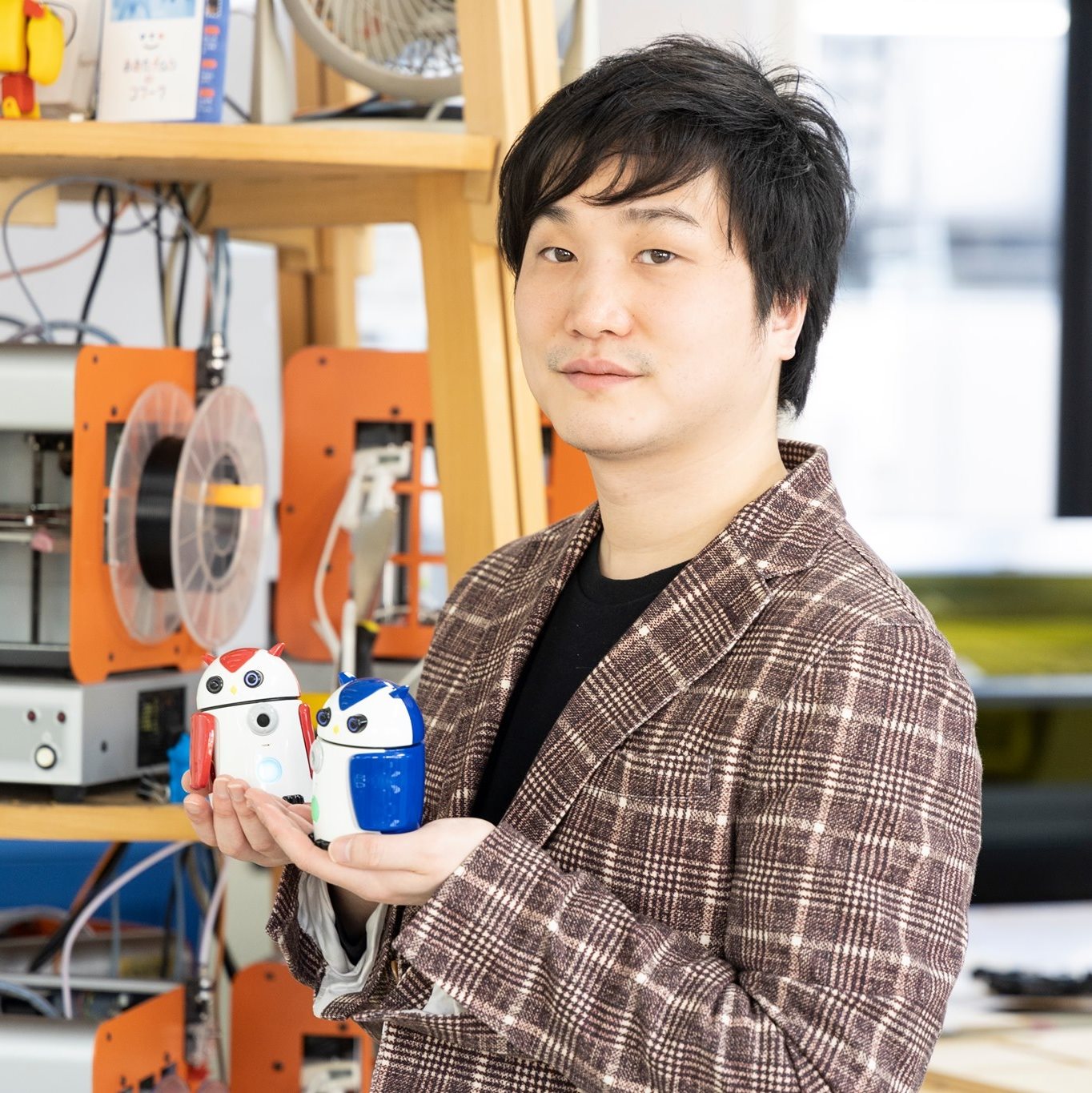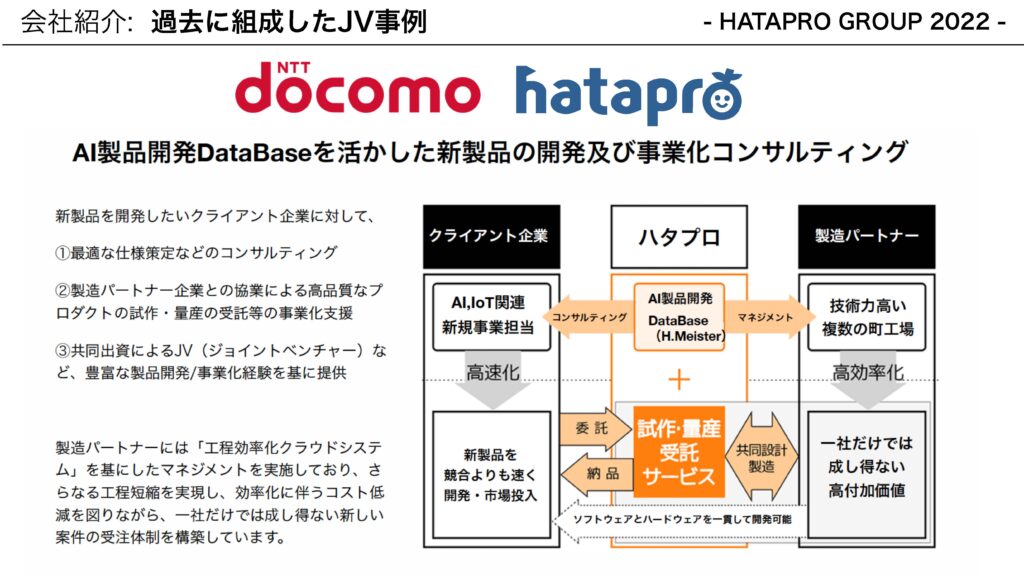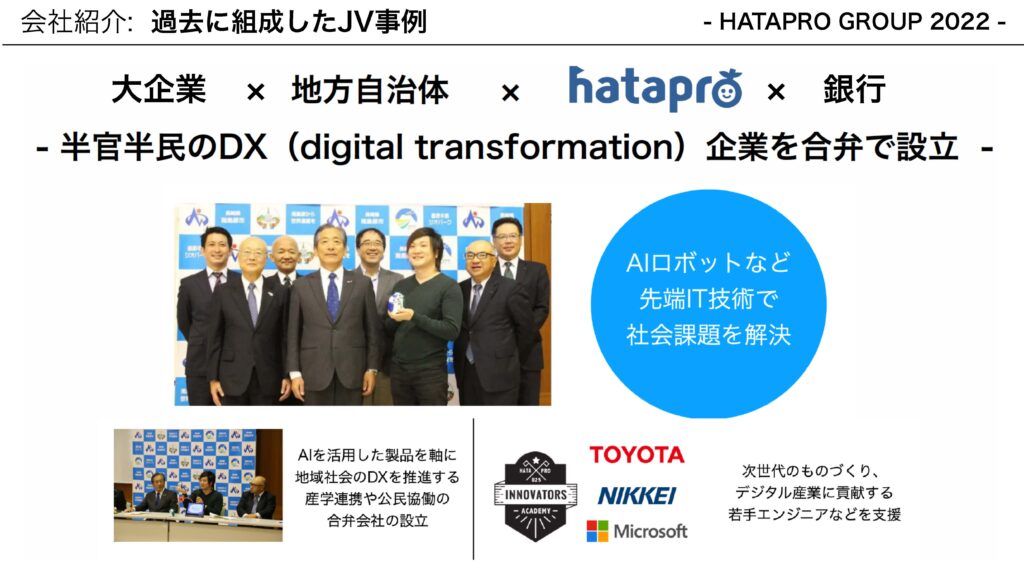Mr. Ryota Izawa, Representative Director of HATAPRO, INC.
When talking about AI and IoT, mass production is one of the key barriers to commercialization. However, there is a company that completely undertakes every step of development, from prototyping to mass production, without fragmenting the business in the process. In this case, the company, HATAPRO, INC. moves fluidly and efficiently from software development to hardware manufacturing. This is an interview with Mr. Ryota Izawa, the Representative Director of the company, about their flexible business model, which is maintained without losing its agility as a startup despite its many collaborations with large corporations and local governments.
―Could you tell us about HATAPRO, INC.?

Representative Director of HATAPRO, INC.
HATAPRO, INC. was found in 2010, and focuses on AI research and development.
We are affiliated with a robot manufacturer and a company developing wireless communication devices and IoT.
―Do you have any business areas where you are demonstrating your strength?
We excel in healthcare-related AI among other AI areas.
In collaboration with the University of Tokyo and the Osaka University Hospital, we have produced a number of products and technologies. In addition, we have been selected for the AI Hospital project of the Cabinet Office and other projects in preparation for Osaka Expo 2025, which has earned us recognition in the industry as a company that is strong in both healthcare and AI robots.
Our focus is on research and development, but is not limited to them. We have also implemented many group management strategies by establishing joint companies through mutual investments of capital and by creating and expanding joint ventures. We are often viewed as a very unique company in that we, a small startup, form a group with a large company or local government by investing as equals.
―What kind of companies do you work with?
In recent years, we have collaborated with leading companies in various industries, including NTT DOCOMO, INC., Japan Airlines Co., Ltd., Recruit Co., Ltd., and Benesse Holdings, Inc. in product development and other fields.
For example, we are currently involved in the technology behind interactive AI robots for children’s learning.
―Could you tell us about any of your specific initiatives?
One of our recent initiatives is an oral care project in cooperation with NTT DOCOMO. The government’s announcement of universal dental checkups drew people’s attention to this issue. Targeting this sector, we are jointly developing an AI robot that can provide unattended, contactless, and automatic oral function training.
―What are your company’s core strengths?
We can plan and develop hardware at a high speed.
At a speed that can be achieved only by a startup, we develop a product with quality as high as that of mass-produced products from listed companies. Armed with both the experience and techniques needed to succeed, we can handle the entire development process, from prototyping to mass production.
Since we use a fabless manufacturing model, we have built a network of partner manufacturers as we work on a variety of projects. Our network is large and flexible to new areas.
This means that we have a mechanism that allows us to rapidly develop a business focused not only on AI development but also on the hardware.
―How quickly can you do that?
We can develop a prototype in a month compared to the market average of six months. It usually takes several years to develop a mass product, but we can develop one in a year. That’s how quickly we can do what we do.
We can achieve this speed because we can freely select our factories and build a team that is appropriate for a given project.
Recently, there has been a shortage of semiconductors, but we don’t have any predetermined factories, so we can flexibly form a team to keep up with the changing times.
―You say that you can also achieve rapid mass production, but what scale of mass production are you referring to?
It’s several hundred thousand units.
―When it comes to that scale, your partner manufacturers won’t work with you unless they trust you, right?
That’s right. They do trust us.
At the mass production level, a factory of a listed company will be in charge of manufacturing for us, establishing a speedy mass production system while ensuring quality.
From the beginning of prototype development, we will be involved and connected with the factory. In the case of IoT, a company that has never produced anything may become a producer. Our involvement from the ground up can help such companies communicate smoothly with volume manufacturers, instead of talking to them out of the blue.
―What are your strengths with regard to IoT?
We have been working with telecommunications companies for a long time, so we have an edge in IoT, which itself involves communication.
In the field of IoT, I suppose there are many manufacturers that have only made products that do not involve communication. IoT is like mixed martial arts in that it requires a very broad range of knowledge and corresponding skills and networks in terms of software, hardware, and communication.
We have been very capable because we have dealt specifically with this issue since our early days.
Another big advantage is that we are working with the biggest players in the industry.
―You mentioned that you are also working with local governments on joint ventures. What kind of role are you playing there?
We ourselves are a venture business and create semi-private ventures involving local governments, which I would say is quite unique.
I’ve never heard of another company doing this.
In most cases of semi-governmental joint ventures, both parties involved are usually large and take a lot of time to work on their ventures. On the other hand, we are again quick to team up with large companies, local governments, local banks, create jobs in the local area, and help local people achieve the digital transformation of the community on their own. This is what we do, including education.
―That’s amazing. Could you give us a specific example of that?
The most recent example is a project called “NEO KYOTO NFT ARTs.”
This is a Web 3.0 education project created jointly with WACOAL CORP. and SMBC Nikko Securities Inc. It’s a very unusual project in that it’s a semi-governmental project where an established manufacturer (WACOAL), a startup (HATAPRO), and a member of a conglomerate (SMBC) are involved.
Kyoto, which has the largest proportion of students in the population in Japan, is providing students with a variety of educations, including in digital art and art thinking, and is allowing students to draw images in a virtual space.
The art drawn in the virtual space will be exhibited and sold globally as a tourist attraction. A portion of the sales proceeds will be given back to education in Kyoto City over the long term.
In this way, local people and assets can create new value on their own and give back to local education. We are doing this with a new technology called non-fungible tokens (NFT).
In addition to the private companies, the educational department of the Kyoto municipal government and the city’s tourism association are involved in this project, making it very unique in the industry.
We believe that such a project can also be implemented in other municipalities through various schemes.
| Company name:HATAPRO, INC. |
| Founded:November 2010 |
| Main businesses:Planning and development of AI robots and consulting on prototyping and manufacturing URL:https://hatapro.co.jp |
This article is part of a series of articles introducing venture companies working together as ICF members to resolve societal issues.







